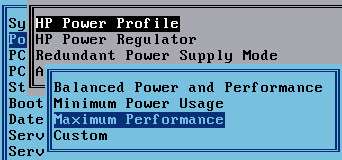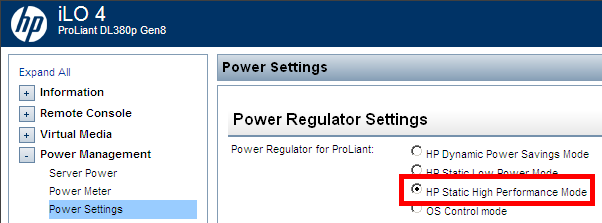The Effects of HP’s Power Profile on vCPU Performance
When you buy a new HP server it comes with the BIOS setting HP Power Profile set to Balanced Power and Performance. That sounds good but is bad – at least for CPU performance in a VDI environment.
When we prepared our servers for use as virtualization hosts for Citrix XenDesktop we took great care to configure the HP Power Profile for Maximum Performance:

That fixed the problems with really awful CPU performance we had in the beginning. But still – some VMs were performing worse than others. When I looked at the problem I soon found a VM with bad CPU performance. I ran some benchmarks, comparing it to a “good” VM:
Test setup:
CPU: Xeon E5-2670 2.6 GHz
Hypervisor: VMware ESXi 5.0 Update 1
VM OS: Windows 7 64 Bit
VM configuration: 2 vCPUs
| Benchmark | Good VM | Bad VM |
|
Cinebench 11.5 CPU >> more is better |
2.20 | 1.48 |
|
NovaBench CPU Test >> more is better |
262 | 204 |
|
Super Pi 1M [s] << less is better |
13.2 | 32.2 |
Depending on the benchmark, the “good” VM is between 28% and 244% faster than the “bad” VM. That is a lot!
I suspected the power profile setting of the server hosting the “bad” VM to be wrong, but how to check without rebooting the server and accessing the BIOS? These are production systems and we cannot use vMotion to move the VMs off the server because the VMs are on local storage. Luckily the power profile setting is not only available from the BIOS, but from the iLO console, too. It can even be changed from iLO, taking effect immediately:

Sure enough, the “bad” VM was on a server with incorrectly configured power profile. Switching it to HP Static High Performance Mode fixed the issue. Strangely, the settings are named differently in BIOS and iLO.
If you want to know more about power profiles and power regulator: HP has a whitepaper on the topic.






9 Comments
Hi
Can you tell me how you tested? My guess (but I’m not sure either) would be that if you have no load on the host and then suddenly run these tests, that the test results will show a difference compared to when you run the tests for an hour or so and fully load the host.
Would you have more information on how HP’s performance mode works? When it “kicks in”? Think that is very important with your testing.
Gabrie
Hi Gabrie,
I ran the tests on a production machine, i.e. the host had about 30 VMs running a VDI workload. As I mentioned in the article I noticed badly performing VMs in production and could not reboot or do a vMotion. So I simply logged on to the badly performing VM (Win7 x64), ran the benchmarks a few times, changed the power profile setting and ran the benchmarks again.
Helge
Hi, could you please further help me understand if a reboot is required after changing the Power Settings? I understand it is an older blog but appreciate if anyone could clarify at the earliest.
Thanks Helge, already knew it needs to be changed but wasn’t expecting dramatic results. Just started troubleshooting a performance issue for a customer and this setting already helped a bit. At least performance counters are not influenced anymore by power settings.
“Strangely, the settings are named differently in BIOS and iLO.”
Err… no! The Power Regulator Setting in iLO represents the Power Regulator Setting in BIOS. The Power Profile in BIOS is something else.
There is a VMware KB article about the recommended power management settings for HP Proliant G6+ machines (KB 1018206).
The short version is: set
HP Power Profile to Custom,
HP Power Regulator to OS Control Mode,
Redundant Power Supply Mode to High Efficiency Mode (Auto)
and control the Power Management through the ESXi Settings. Default is Balanced. Set to High performance if needed.
Note also that setting HP Power Regulator to OS Control Mode requires a reboot of the system to take effect (since it has to set up ACPI tables).
We suspect this setting significantly improved query times on our system, which was not heavily loaded per-se but had many interactive queries.
“The Power Regulator Setting in iLO represents the Power Regulator Setting in BIOS. The Power Profile in BIOS is something else.”
That’s not entirely accurate. From: http://h20566.www2.hpe.com/hpsc/doc/public/display?docId=emr_na-c00300430
“Choosing the HP Power Profile “Maximum Performance” setting activates the Power Regulator Static
High Performance mode which does not affect VMware performance, but also disables other power
savings features unrelated to P-state control. The HP Power Profile includes a “Custom” setting that
doesn’t disable these additional power savings features. We recommend that you change the Power
Regulator option to Static High Performance independently, which automatically puts the HP Power
Profile setting into the Custom mode.”
Is there some method to verify from the iLO or OS command line both the HP Power Profile and HP Power Regulator setting? I only see such a method to view/change the second setting. To check or change the Power Profile it seems like you need to power cycle the blade and enter the ROM Based Setup Utility (RBSU)
Wow! I know this is an old thread but it will help anyone, this worked instantly! no reboot required.
Some processes were using up to 90% CPU but immediately after the change, this went down to 35%
Thank You!